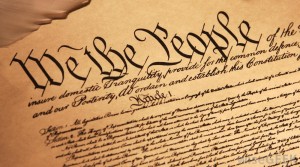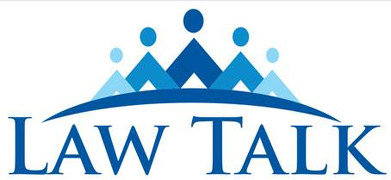One consequence of this month’s terrorist attack on the Charlie Hebdo office in Paris is a renewal of the age-old debate over appropriate limits on speech. For the benefit of those not well-versed in American law, this blog article explains how government infringement of speech gets analyzed in the United States.
First, what is speech? Most people think of it as the expression of ideas using words, whether spoken or written. However, speech can also consist of symbolic non-verbal means to communicate a message or idea.
The analysis of a limit on speech begins with the “free speech clause” of the First Amendment to the US Constitution.
 During the colonial period, England had censored the press and punished people who dared to criticize the British Crown. The Constitution didn’t initially address freedom of speech, but the very first amendment, effective as of late 1791, stated:
During the colonial period, England had censored the press and punished people who dared to criticize the British Crown. The Constitution didn’t initially address freedom of speech, but the very first amendment, effective as of late 1791, stated:
Congress shall make no law . . . abridging the freedom of speech.
On its face, this applies only to acts of Congress. For a good part of American history, this limitation was strictly interpreted. However, it’s now settled law that the First Amendment’s protection of speech applies also to the other branches of the federal government, as well as to all branches of state governments.
Who are the parties protected by the First Amendment’s free speech clause? There are two categories: speakers, who can speak or otherwise express ideas freely; and people in general, who get to decide for themselves what to read, see, and hear.
Whenever a court is asked to review a government abridgment of speech, the challenge might be facial, contesting the constitutionality of the abridgment of speech in all cases; or it might challenge the government rule or action only as applied to specific facts.
For analyzing limits on speech, American courts have identified various categories. First comes political speech. It’s often said that participation in the democratic political process is most effective when the participant can (a) hear all points of view to make decisions for himself or herself, and (b) share his or her own point of view with others.
Next comes commercial speech, such as advertising or public relations statements. Commercial speech can overlap with political speech when speakers with commercial motivations and goals participate in the political process.
Third comes artistic speech: novels, poems, plays, songs, choreography, painting, performance art, and so forth.
The next two types of speech are related but definitely not identical: indecent speech and obscenity. Speech is indecent if offensive as defined by community standards: certain profane 4-letter words provide an example. On the other hand, speech is obscene if it appeals to the average person’s shameful interest in sex, depicting sexual conduct in a patently offensive way as defined by community standards, and lacking serious literary, artistic, political, or scientific value. (This vague definition is sometimes called the “I know it when I see it” test).
Another category is “fighting words” expressed to incite hatred or violence from their target.
The final category of speech is a catch-all, miscellaneous speech. Basically, it’s everything else.
Where the government seeks to regulate the content of speech, it typically must provide an extremely strong justification. The test is like the one used for race-based discrimination, called “strict scrutiny.” In general, the government must have a compelling interest to advance, and the challenged action must be the least restrictive means to achieve that compelling interest.
Nonetheless, the courts have made adjustments for the regulation of special types of content: for commercial speech, a weaker justification is sufficient, although there’s more protection now for commercial speech than there was in the past. Indecent speech can be regulated in broadcast and cable media. Obscene speech is not at all constitutionally protected. Fighting words can be punished if their utterance alone inflicts injury or tends to incite an immediate breach of the peace)
Where the government seeks to regulate not the content of speech, but rather its place, time, and manner while remaining neutral with respect to content, the government’s justification can be less strong. The test is called “intermediate scrutiny,” not as severe as strict scrutiny, but still stricter than the “rational basis” test that sets the floor for the constitutionality of government action.
From these tests, we can derive the following two overarching principles. First, the government in the US cannot generally limit expression simply because a listener (or even most listeners) would be offended by the expression’s content. Second, expression can be restricted only if it will clearly cause direct and imminent harm to an important societal interest. (The classic example is shouting, “Fire!” in a crowded theater.)
There are all sorts of interesting applications of these rules. What happens when these rules bump into other rules regarding libel and defamation? How does symbolic speech such as burning the national flag fit into these rules? Can a convicted felon profit from the sale of a published memoir? Can a musical group record and distribute a song about a toy protected by trademark? These are just a few examples of the kind of cases that have kept the courts busy with First Amendment challenges.
Back to the recent events in France and the way that they’ve prompted a renewal of the age-old debate over appropriate limits on speech. As Kenan Malik framed the issue in a recent Op-Ed piece in The New York Times,
France’s attitude to free speech is fraught. On one hand, the republic prides itself as the nation of Voltaire, with a tradition of trenchant social satire — to which Charlie Hebdo clearly saw itself as heir. On the other hand, France has restrictive privacy laws, some of the toughest hate speech laws in the European Union and a ban on Holocaust denial. This combination of Voltairean bravado and restrictive measures has created a deeply contradictory attitude toward free speech.
Law Talk isn’t likely to convince any reader to change his or her view of the appropriate limits on speech in France, but Law Talk supports the notion most eloquently articulated by US Supreme Court Justice Louis Brandeis in 1927 :
If there be time to expose through discussion the falsehood and fallacies, to avert the evil by the process of education, the remedy to be applied is more speech, not enforced silence.
